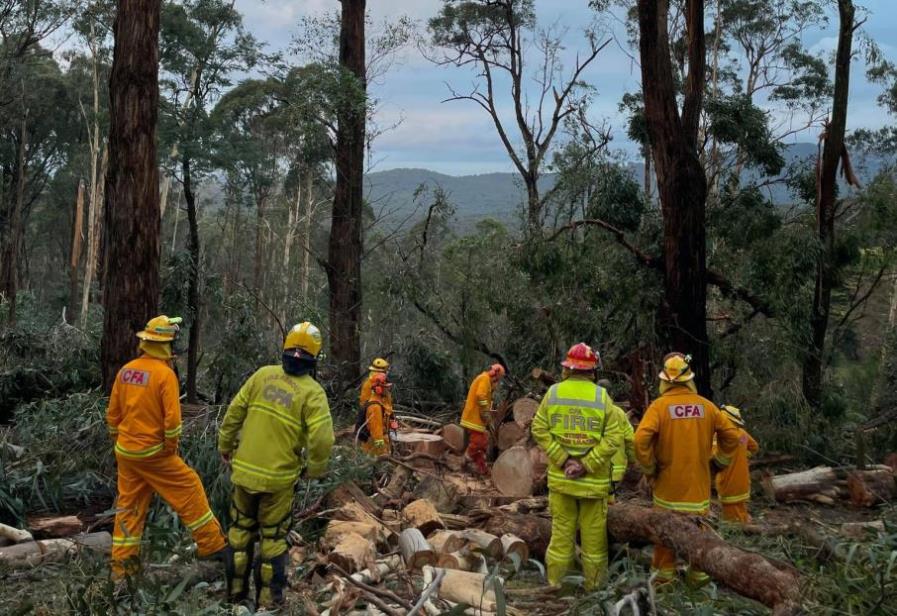
On Wednesday 9 June Victoria experienced one of its most intensive storm events in many years. Clematis Brigade Captain Jarryd Miller spoke about the recent extreme weather conditions and the strike team efforts to support the recovery in the Dandenong Ranges.
“At around 10.30pm on Wednesday, as the strong winds were starting to come through, the brigade responded to a call-out to fallen trees and powerlines in Kilvington Drive in Emerald. When we arrived, people had taken to the street where high voltage and low voltage lines were down across cars, people’s fences had collapsed and trees were blocking roads.
Kilvington Drive is a narrow road with large trees either side so we knew this could put people in a very dangerous situation. After directing residents to take settle indoors we got to work securing barrier tape quickly to block off the road. Shortly after this we received a pager informing all members to return to station as weather conditions were becoming severe at the top of Mount Dandenong.
That was luckily our only call on the night of the storms but the enormous radio traffic for the top of the mountain made it apparent they were experiencing a completely different situation.
On Saturday 12 June, Clematis Fire Brigade members Dan Edwards, Mark Lane and myself were deployed to the Dandenong Ranges as part of Strike Team 1332. Arriving at Olinda on the Clematis Tanker 2, I was honestly shocked to see the amount of damage on the way up from Mobulk through the town. It was crazy. But little did I know that wouldn’t be the worst of it.
Strike teams 1332, 1333 and 1334 met at Olinda Oval to plan our recourses for the day. The strike teams consisted of 42 members, three strike team leaders, six tankers, two FCVs, one ultralight, one salvage and one lighting unit.
Strike team 1332 headed to Childs Road which had been badly hit by the storms. As we drove there, we were truly shocked with the number of trees and damage that had been caused. Along the Mount Dandenong Tourist Road enormous historic trees had been dropped in the strong winds destroying everything in their path, some of the biggest trees I have ever seen. I instantly thought what It must have been like on Wednesday night hearing and seeing these horrific conditions.
We arrived on Childs Road where we were tasked with opening the road which had been closed since the storms first hit. Cutting through trees and clearing the debris, we were approached by one of the local residents who informed us his driveway was completely swamped by trees and he hadn’t been able to move his vehicle out to get supplies since Wednesday.
His driveway was about 250 metres long, he had 10 huge trees blocking the drive and it was going to take him months to clear. It was amazing that the property hadn’t been destroyed as there would have been 30 to 40 fallen trees surrounding the property.
He looked truly overwhelmed and exhausted. We knew we had to try to help him out with the time we had. Dan, Mark and myself started to cut up the trees and we ended up spending most of the morning there. It was some of the hardest manual labour we’ve done on a strike team.
At lunch, we got called back to the Kalorama Fire Station to eat and after having a chat about the work we’ve been doing the strike team leaders decided to get both strike teams that were working on the mountain there to tackle the mammoth task.
As we arrived, the residents were overwhelmed with happiness. They were nearly in tears because suddenly there were 8 CFA vehicles rolling down his driveway to chip in and get the job done.
We managed to get some support from Forest Fire Management Victoria and their excavator which could lift big chunks of tree. Because there were so many of us, we managed to clear the driveway for his vehicle to get through just as it became dark and we were due to clock off.
It was probably one of the most rewarding strike teams I’ve been on. To be able to see the job through and work alongside the residents, I’ll always remember that. You could see just how much it meant to these people as they would have still been going if they didn’t have the manpower there.
Working alongside the other emergency services was great. It’s going to take months for residents to get back to normal. Some residents haven’t even come back since leaving on the night of the storms and some will be coming back to see entire property destroyed, so it’s great to be able to help in even the smallest way.
This really showed me that CFA doesn’t just respond to fires; it’s about so much more than that.”
| Submitted by |
Holly Penketh |